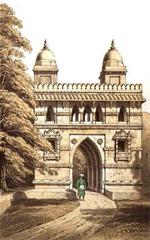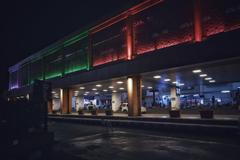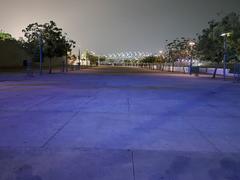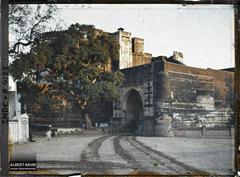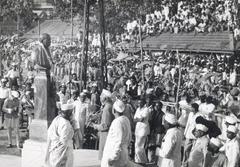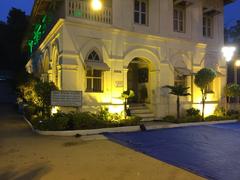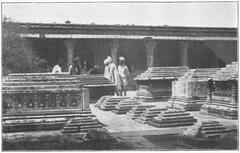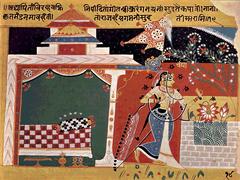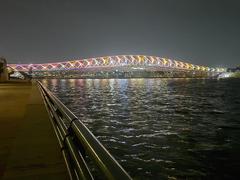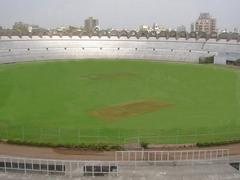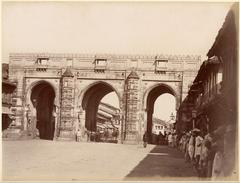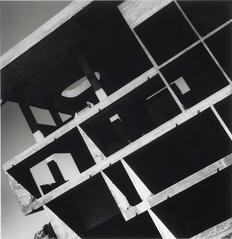
Swaminarayan Museum Ahmedabad: Visiting Hours, Tickets, and Complete Guide
Date: 04/07/2025
Introduction
The Swaminarayan Museum in Ahmedabad is a remarkable destination that weaves together the spiritual legacy and cultural history of Bhagwan Shree Swaminarayan, founder of the Swaminarayan Sampraday. Established to preserve and display more than 3,000 personal artifacts, manuscripts, and relics, the museum offers an immersive experience for devotees, scholars, and travelers alike. Located in the Naranpura area of Ahmedabad—a city renowned for its UNESCO World Heritage status—the museum stands as a bridge between religious tradition and modern museology, with thoughtfully curated exhibition spaces, serene gardens, and a commitment to education and inclusivity.
This guide provides detailed insights into the museum’s historical context, visiting hours, ticketing, major collections, architectural features, visitor facilities, and nearby attractions—helping you plan a memorable visit.
Table of Contents
- Historical Background and Significance
- Practical Information for Visitors
- Museum Layout and Collections
- Architectural and Aesthetic Features
- Visitor Facilities and Accessibility
- Nearby Attractions and Travel Tips
- Frequently Asked Questions (FAQ)
- Conclusion and Visitor Recommendations
- References and Further Reading
Historical Background and Significance
The Swaminarayan Tradition and Its Founder
Bhagwan Shree Swaminarayan, born Sahajanand Swami in 1781 in Chhapaiya near Ayodhya, is revered as an incarnation of Lord Krishna by followers of the Swaminarayan Sampraday. After a transformative pilgrimage across India, he settled in Gujarat, championing moral living, compassion, and social reform—including the upliftment of women and marginalized communities. By the time of his passing in 1830, his movement had established six major temples in Gujarat and amassed a following of nearly two million devotees.
Genesis of the Swaminarayan Museum
The museum was realized through the vision of H.H. Shree TejendraPrasadji Maharaj, a direct descendant in Swaminarayan’s spiritual lineage. With a mission to safeguard and showcase Swaminarayan’s sacred belongings (prasadi), the museum was funded through donations during the Acharya’s 60th birthday celebrations. The collection includes precious handwritten manuscripts and personal effects, uniting artifacts from temples and private devotees worldwide.
Swaminarayan in Ahmedabad
Ahmedabad holds a special place in Swaminarayan history—here, the first Swaminarayan temple was established in Kalupur in 1822. The museum in Naranpura continues this tradition, making Ahmedabad an important pilgrimage and cultural center.
Practical Information for Visitors
Visiting Hours and Days
- Standard Hours: 10:00 AM to 6:00 PM, Tuesday to Sunday
- Closed: Mondays and select public holidays
- Festival Hours: May be extended during major religious events (confirm in advance)
Ticket Prices and Entry
- Adults: ₹100
- Children (5–15 years): ₹50
- Senior Citizens: ₹50
- Children under 5: Free
Tickets are available at the museum entrance. Group discounts and special rates may apply during festivals and events. It is advisable to check the official museum website or contact the museum directly for the latest information.
Location and How to Reach
- Address: Pujya Dharmsingh Swami Marg, behind AEC Tower, Sundar Nagar, Naranpura, Ahmedabad, Gujarat 380013, India
- Public Transport: Easily accessible by city buses, auto-rickshaws, and taxis
- Parking: Onsite parking is available for private vehicles
Museum Layout and Collections
Architectural Overview
Spanning 175,000 sq. ft., the museum’s modern complex features 12 thematic exhibition halls, a mini-theatre, library, conservation lab, canteen, and guest facilities. The design harmonizes traditional Swaminarayan architectural motifs with contemporary amenities.
Collection Highlights
- Personal Garments and Ornaments: Everyday and ceremonial clothing, jewelry, and chakhdi (wooden sandals)
- Manuscripts and Documents: Including the only known signed document by Swaminarayan—a power of attorney related to temple land
- Physical Relics: Footprints, hair, nail clippings, and spectacles
- Religious Implements: Utensils, prayer beads, and handwritten scriptures
- Gifts and Historical Artifacts: Items presented to and by Swaminarayan, with detailed provenance
Thematic Halls
The 12 exhibition halls explore Swaminarayan’s life, social reforms, teachings, disciples, and the global spread of the Sampraday. Interactive digital kiosks, dioramas, and multilingual panels (Gujarati, Hindi, English) enhance accessibility and engagement.
Special Features
- Mini Theatre: Screening documentaries and devotional films
- Library: Rare books and manuscripts for research
- Conservation Lab: Artifact preservation and replica production
- Canteen: Serves hygienic, vegetarian meals (onion- and garlic-free)
Architectural and Aesthetic Features
The museum’s architecture incorporates:
- Traditional Gujarati Temple Motifs: Intricate carvings and symbolic elements.
- Landscaped Gardens: Tranquil spaces for reflection.
- Climate-Controlled Galleries: For artifact preservation.
- Accessible Pathways: Ramps and elevators throughout.
Visitor Facilities and Accessibility
- Restrooms: Clean and well-maintained.
- Cloakroom: Secure storage for personal items.
- Seating Areas: Benches throughout the galleries and gardens.
- Guided Tours: Available in English, Gujarati, and Hindi (book on-site or in advance).
- Audio Guides: Multilingual, for self-paced exploration.
- Gift Shop: Souvenirs, religious literature, and memorabilia.
- Wheelchair Accessibility: Ramps, elevators, and accessible restrooms.
- Parking: Free onsite parking.
Nearby Attractions and Travel Tips
Major Nearby Sites
- Swaminarayan Mandir, Kalupur: Historic temple and spiritual headquarters.
- Sabarmati Ashram: Gandhi’s former residence.
- Calico Museum of Textiles: World-renowned textile collection.
- Kankaria Lake: Urban recreational area.
Travel Tips
- Best Time to Visit: November to February for pleasant weather; mornings and weekdays for a quieter experience.
- Dress Code: Modest attire recommended; footwear may need to be removed in certain sections.
- Photography: Allowed in designated areas without flash; always check signage.
- Food: Onsite canteen available; numerous dining options in Naranpura and nearby neighborhoods.
Frequently Asked Questions (FAQ)
Q: What are the Swaminarayan Museum visiting hours? A: 10:00 AM to 6:00 PM, Tuesday to Sunday; closed Mondays and select holidays.
Q: What is the ticket price? A: Adults ₹100, children (5–15 years) and senior citizens ₹50, children under 5 free.
Q: Is the museum wheelchair accessible? A: Yes, with ramps, elevators, and accessible restrooms.
Q: Are guided tours available? A: Yes, in multiple languages; book at the entrance or in advance.
Q: How do I reach the museum by public transport? A: City buses, auto-rickshaws, and taxis serve the area; parking is available for private vehicles.
Q: Are there any restrictions on photography? A: Photography is generally allowed in public areas, but flash and tripods may be restricted.
Q: What nearby sites can I visit? A: Swaminarayan Mandir, Sabarmati Ashram, Calico Museum of Textiles, and Kankaria Lake.
Conclusion and Visitor Recommendations
The Swaminarayan Museum in Ahmedabad stands as a living testament to the teachings and legacy of Bhagwan Shree Swaminarayan. Its world-class collections, immersive exhibitions, and welcoming environment offer deep insight into the religious, social, and cultural fabric of Gujarat. Whether you are a devotee, student, or traveler, the museum provides a spiritually uplifting and educational experience.
Plan Your Visit:
- Check the official museum website for the latest hours, ticketing, and event updates.
- Download the Audiala app for guided tours and explore more about Ahmedabad’s cultural landscape.
- Respect local customs, dress modestly, and enjoy the tranquil ambiance.
References and Further Reading
- Swaminarayan Museum
- Wikipedia
- MyTrip Guide
- Joonsquare
- Ahmedabad Tourism
- Wanderboat
- Culture and Heritage
- Swaminarayan.in
- Yappe.in
- The Tourist Checklist
- Madhu On The Go


